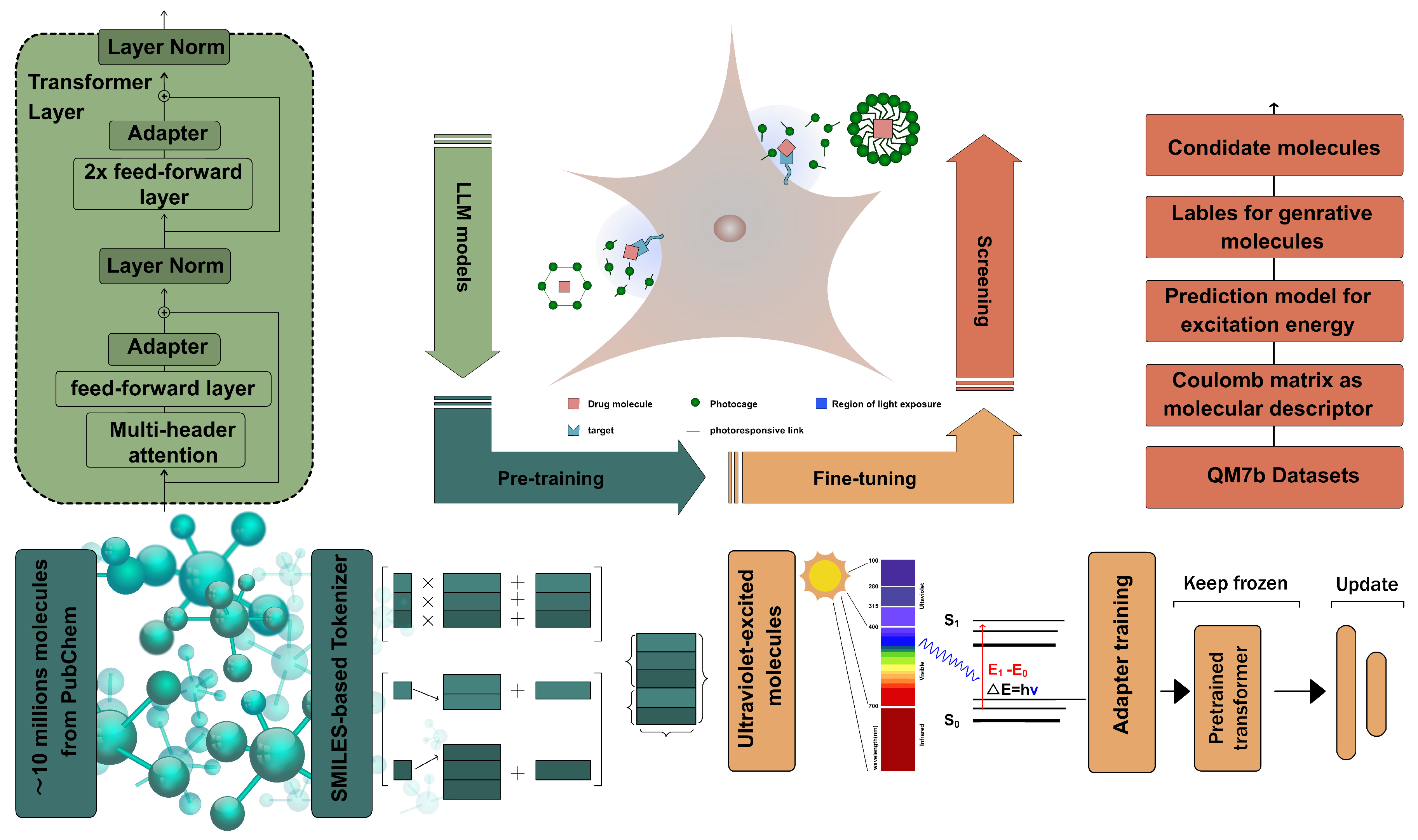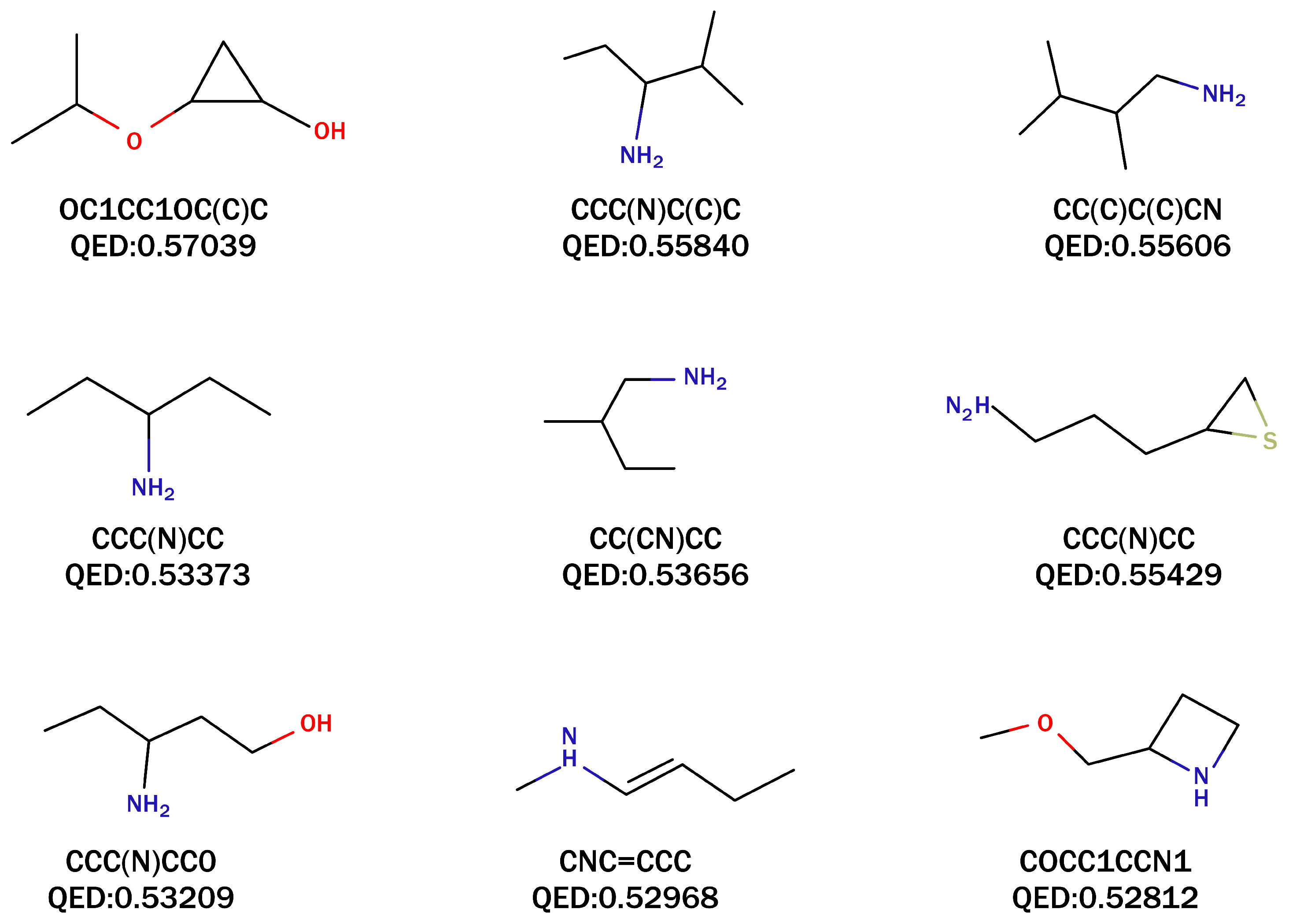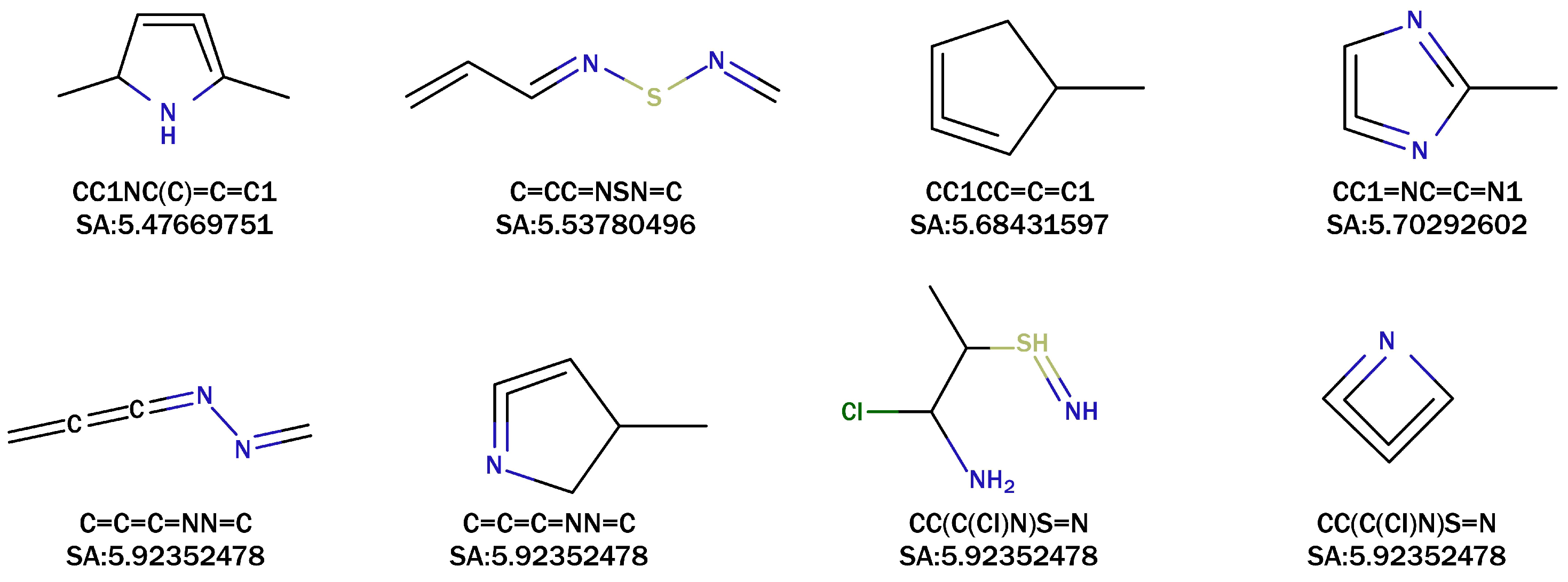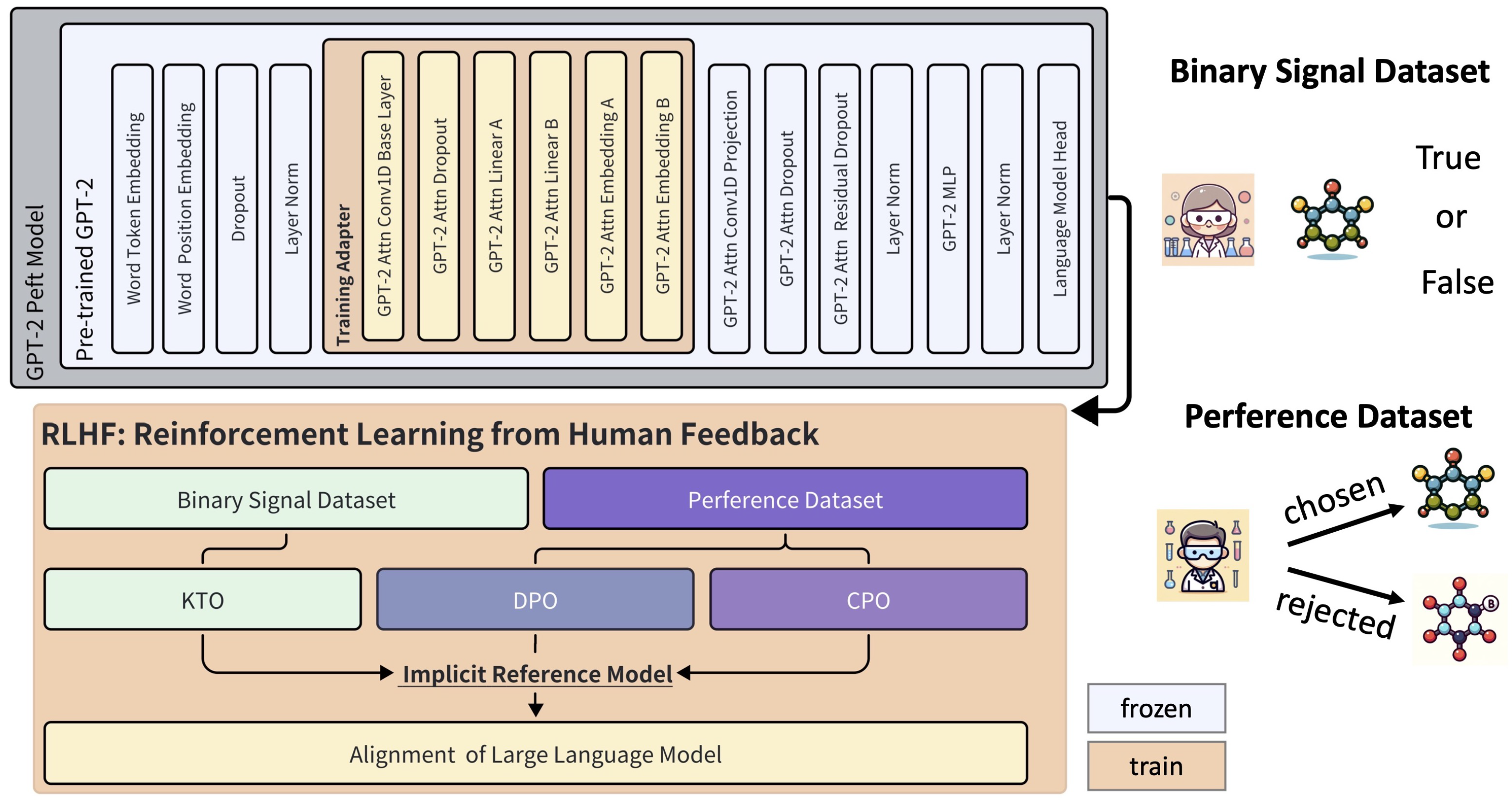A Human Feedback Strategy for Photoresponsive Molecules in Drug Delivery: Utilizing GPT-2 and Time-Dependent Density Functional Theory Calculations
Abstract
1. Introduction
2. Materials and Methods
3. Results and Discussion
3.1. Generative Workflow for Photoresponsive Drug Delivery
3.2. Screening the Generative Molecules
3.3. Quantum Chemical Calculations
3.4. Fine-Tuning with Human Feedback
- The molecule has a polyatomic ring structure.
- The atomic ring structure contains more than one unsaturated chemical bond.
- The ring structure includes non-carbon atoms, such as nitrogen (N), sulfur (S), oxygen (O), etc.
4. Future Work
Author Contributions
Funding
Institutional Review Board Statement
Informed Consent Statement
Data Availability Statement
Acknowledgments
Conflicts of Interest
References
- Vargason, A.M.; Anselmo, A.C.; Mitragotri, S. The evolution of commercial drug delivery technologies. Nat. Biomed. Eng. 2021, 5, 1–17. [Google Scholar] [CrossRef] [PubMed]
- Hassanzadeh, P.; Atyabi, F.; Dinarvand, R. The significance of artificial intelligence in drug delivery system design. Adv. Drug Deliv. Rev. 2019, 151–152, 169–190. [Google Scholar] [CrossRef] [PubMed]
- Meenakshi, D.U.; Nakumar, S.; Francis, A.P.; Sweety, P.; Fuloria, S.; Fuloria, N.K.; Subramaniyan, V.; Khan, S.A. Deep Learning and Site-Specific Drug Delivery; Wiley: Hoboken, NJ, USA, 2022; pp. 1–38. [Google Scholar] [CrossRef]
- Vora, L.K.; Gholap, A.D.; Jetha, K.; Thakur, R.R.S.; Solanki, H.K.; Chavda, V.P. Artificial Intelligence in Pharmaceutical Technology and Drug Delivery Design. Pharmaceutics 2023, 15, 1916. [Google Scholar] [CrossRef] [PubMed]
- Tao, Y.; Chan, H.F.; Shi, B.; Li, M.; Leong, K.W. Light: A Magical Tool for Controlled Drug Delivery. Adv. Funct. Mater. 2020, 30, 2005029. [Google Scholar] [CrossRef] [PubMed]
- Liu, D.; Yang, F.; Xiong, F.; Gu, N. The Smart Drug Delivery System and Its Clinical Potential. Theranostics 2016, 6, 1306–1323. [Google Scholar] [CrossRef] [PubMed]
- Lan, G.; Ni, K.; Lin, W. Nanoscale metal–organic frameworks for phototherapy of cancer. Coord. Chem. Rev. 2019, 379, 65–81. [Google Scholar] [CrossRef] [PubMed]
- Bouchaala, R.; Anton, N.; Anton, H.; Vamme, T.; Vermot, J.; Smail, D.; Mély, Y.; Klymchenko, A.S. Light-triggered release from dye-loaded fluorescent lipid nanocarriers in vitro and in vivo. Colloids Surfaces B Biointerfaces 2017, 156, 414–421. [Google Scholar] [CrossRef] [PubMed]
- Son, J.; Yi, G.; Yoo, J.; Park, C.; Koo, H.; Choi, H.S. Light-responsive nanomedicine for biophotonic imaging and targeted therapy. Adv. Drug Deliv. Rev. 2019, 138, 133–147. [Google Scholar] [CrossRef] [PubMed]
- Jia, S.; Fong, W.-K.; Graham, B.; Boyd, B.J. Photoswitchable Molecules in Long-Wavelength Light-Responsive Drug Delivery: From Molecular Design to Applications. Chem. Mater. 2018, 30, 2873–2887. [Google Scholar] [CrossRef]
- Cho, H.J.; Chung, M.; Shim, M.S. Engineered photo-responsive materials for near-infrared-triggered drug delivery. J. Ind. Eng. Chem. 2015, 31, 15–25. [Google Scholar] [CrossRef]
- Liu, J.; Kang, W.; Wang, W. Photocleavage-based Photoresponsive Drug Delivery†. Photochem. Photobiol. 2021, 98, 288–302. [Google Scholar] [CrossRef] [PubMed]
- Barhoumi, A.; Liu, Q.; Kohane, D.S. Ultraviolet light-mediated drug delivery: Principles, applications, and challenges. J. Control. Release 2015, 219, 31–42. [Google Scholar] [CrossRef] [PubMed]
- Weissleder, R. A clearer vision for in vivo imaging. Nat. Biotechnol. 2001, 19, 316–317. [Google Scholar] [CrossRef] [PubMed]
- Bagheri, A.; Arandiyan, H.; Boyer, C.; Lim, M. Lanthanide-Doped Upconversion Nanoparticles: Emerging Intelligent Light-Activated Drug Delivery Systems. Adv. Sci. 2016, 3, 1500437. [Google Scholar] [CrossRef] [PubMed]
- Karimi, M.; Zangabad, P.S.; Baghaee-Ravari, S.; Ghazadeh, M.; Mirshekari, H.; Hamblin, M.R. Smart Nanostructures for Cargo Delivery: Uncaging and Activating by Light. J. Am. Chem. Soc. 2017, 139, 4584–4610. [Google Scholar] [CrossRef] [PubMed]
- Linsley, C.S.; Wu, B.M. Recent advances in light-responsive on-demand drug-delivery systems. Ther. Deliv. 2017, 8, 89–107. [Google Scholar] [CrossRef] [PubMed]
- Gao, J.; Karp, J.M.; Langer, R.; Joshi, N. The Future of Drug Delivery. Chem. Mater. 2023, 35, 359–363. [Google Scholar] [CrossRef] [PubMed]
- Harrison, P.J.; Wiesler, H.; Sabirsh, A.; Karlsson, J.; Malmsjö, V.; Hellander, A.; Wählby, C.; Spjuth, O. Deep-learning models for lipid nanoparticle-based drug delivery. Nanomedicine 2021, 16, 1097–1110. [Google Scholar] [CrossRef] [PubMed]
- Schwaller, P.; Laino, T.; Gaudin, T.; Bolgar, P.; Hunter, C.A.; Bekas, C.; Lee, A.A. Molecular Transformer: A Model for Uncertainty-Calibrated Chemical Reaction Prediction. Acs Cent. Sci. 2019, 5, 1572–1583. [Google Scholar] [CrossRef]
- Chithrananda, S.; Grand, G.; Ramsundar, B. ChemBERTa: Large-Scale Self-Supervised Pretraining for Molecular Property Prediction. arXiv 2020, arXiv:2010.09885. [Google Scholar]
- Openai, A.; Openai, K.; Openai, T.; Openai, I. Improving Language Understanding by Generative Pre-Training. 2018. Available online: https://www.mikecaptain.com/resources/pdf/GPT-1.pdf (accessed on 1 July 2024).
- Radford, A.; Wu, J.; Child, R.; Luan, D.; Amodei, D.; Sutskever, I. Language Models are Unsupervised Multitask Learners. OpenAI Blog 2019, 1, 9. [Google Scholar]
- Brown, T.; Mann, B.; Ryder, N.; Subbiah, M.; Kaplan, J.D.; Dhariwal, P.; Neelakantan, A.; Shyam, P.; Sastry, G.; Askell, A.; et al. Language Models are Few-Shot Learners. Adv. Neural Inf. Process. Syst. 2020, 33, 1877–1901. [Google Scholar]
- Gupta, A.; Müller, A.T.; Huisman, B.J.H.; Fuchs, J.A.; Schneider, P.; Schneider, G. Generative Recurrent Networks for De Novo Drug Design. Mol. Inform. 2017, 37, 1700111. [Google Scholar] [CrossRef] [PubMed]
- Adilov, S. Generative Pre-Training from Molecules; Cambridge Engage Preprints: Cambridge, UK, 2021; Volume 16, Available online: https://chemrxiv.org/engage/chemrxiv/article-details/6142f60742198e8c31782e9e (accessed on 25 June 2024).
- Haroon, S.; Hafsath, C.A.; Hafsath, C.A. Generative Pre-trained Transformer (GPT) based model with relative attention for de novo drug design. Comput. Biol. Chem. 2023, 106, 107911. [Google Scholar] [CrossRef] [PubMed]
- Jablonka, K.M.; Schwaller, P.; Ortega-Guerrero, A.; Smit, B. Is GPT-3 All You Need for Low-Data Discovery in Chemistry; Cambridge Engage Preprints: Cambridge, UK, 2023; Volume 14. [Google Scholar]
- Rafailov, R.; Sharma, A.; Mitchell, E.; Manning, C.D.; Ermon, S.; Finn, C. Direct Preference Optimization: Your Language Model is Secretly a Reward Model. Adv. Neural Inf. Process. Syst. 2023, 36, 53728–53741. [Google Scholar]
- Xu, H.; Sharaf, A.; Chen, Y.; Tan, W.; Shen, L.; Van Durme, B.; Murray, K.; Kim, Y.J. Contrastive Preference Optimization: Pushing the Boundaries of LLM Performance in Machine Translation. arXiv 2024, arXiv:2401.08417. [Google Scholar]
- Ethayarajh, K.; Xu, W.; Muennighoff, N.; Jurafsky, D.; Kiela, D. KTO: Model Alignment as Prospect Theoretic Optimization. arXiv 2024, arXiv:2401.08417. [Google Scholar]
- Rupp, M.; Tkatchenko, A.; Müller, K.-R.; von Lilienfeld, O.A. Fast and Accurate Modeling of Molecular Atomization Energies with Machine Learning. Phys. Rev. Lett. 2012, 108, 058301. [Google Scholar] [CrossRef] [PubMed]
- Montavon, G.; Rupp, M.; Gobre, V.; Vazquez-Mayagoitia, A.; Hansen, K.; Tkatchenko, A.; Müller, K.R.; Von Lilienfeld, O.A. Machine learning of molecular electronic properties in chemical compound space. New J. Phys. 2013, 15, 095003. [Google Scholar] [CrossRef]
- Blum, L.C.; Reymond, J.-L. 970 Million Druglike Small Molecules for Virtual Screening in the Chemical Universe Database GDB-13. J. Am. Chem. Soc. 2009, 131, 8732–8733. [Google Scholar] [CrossRef]
- Bickerton, G.R.; Paolini, G.V.; Besnard, J.; Muresan, S.; Hopkins, A.L. Quantifying the chemical beauty of drugs. Nat. Chem. 2012, 4, 90–98. [Google Scholar] [CrossRef] [PubMed]
- Ertl, P.; Schuffenhauer, A. Estimation of synthetic accessibility score of drug-like molecules based on molecular complexity and fragment contributions. J. Cheminform. 2009, 1, 8. [Google Scholar] [CrossRef] [PubMed]
- Neese, F. The ORCA program system. Wiley Interdiscip. Rev. Comput. Mol. Sci. 2011, 2, 73–78. [Google Scholar] [CrossRef]
- Adamo, C.; Barone, V. Toward reliable density functional methods without adjustable parameters: The PBE0 model. J. Chem. Phys. 1999, 110, 6158–6170. [Google Scholar] [CrossRef]
- Weigend, F.; Ahlrichs, R. Balanced basis sets of split valence, triple zeta valence and quadruple zeta valence quality for H to Rn: Design and assessment of accuracy. Phys. Chem. Chem. Phys. 2005, 7, 3297. [Google Scholar] [CrossRef] [PubMed]
- Marenich, A.V.; Cramer, C.J.; Truhlar, D.G. Universal Solvation Model Based on Solute Electron Density and on a Continuum Model of the Solvent Defined by the Bulk Dielectric Constant and Atomic Surface Tensions. J. Phys. Chem. B 2009, 113, 6378–6396. [Google Scholar] [CrossRef] [PubMed]
- Skyner, R.E.; McDonagh, J.L.; Groom, C.R.; van Mourik, T.; Mitchell, J.B.O. A review of methods for the calculation of solution free energies and the modelling of systems in solution. Phys. Chem. Chem. Phys. 2015, 17, 6174–6191. [Google Scholar] [CrossRef] [PubMed]
- Grimme, S.; Antony, J.; Ehrlich, S.; Krieg, H. A consistent and accurate ab initio parametrization of density functional dispersion correction (DFT-D) for the 94 elements H-Pu. J. Chem. Phys. 2010, 132, 154104. [Google Scholar] [CrossRef] [PubMed]
- Grimme, S. Semiempirical GGA-type density functional constructed with a long-range dispersion correction. J. Comput. Chem. 2006, 27, 1787–1799. [Google Scholar] [CrossRef]
- Grimme, S.; Ehrlich, S.; Goerigk, L. Effect of the damping function in dispersion corrected density functional theory. J. Comput. Chem. 2011, 32, 1456–1465. [Google Scholar] [CrossRef]
- Anstine, D.M.; Isayev, O. Generative Models as an Emerging Paradigm in the Chemical Sciences. J. Am. Chem. Soc. 2023, 145, 8736–8750. [Google Scholar] [CrossRef] [PubMed]
- Olejniczak, J.; Carling, C.-J.; Almutairi, A. Photocontrolled release using one-photon absorption of visible or NIR light. J. Control. Release 2015, 219, 18–30. [Google Scholar] [CrossRef] [PubMed]





| Molecular SMILES | First Excitation Energy Converted to Wavelengths | ||
|---|---|---|---|
| Gas Phase | Water | Organic Solvents | |
| CCC(N)CC | 190 | 178 | 181 |
| OC1CC1OC(C)C | 191 | 177 | 180 |
| CCC(N)C(C)C | 193 | 182 | 185 |
| CC(CN)C(C) | 193 | 181 | 184 |
| CC(C)C(C)CN | 197 | 187 | 190 |
| CCC(N)CCO | 199 | 181 | 185 |
| COCC1CCN1 | 201 | 189 | 192 |
| CNC=CCC | 231 | 219 | 222 |
| CC(C(Cl)N)S=N | 226 | 305 | 218 |
| C1=C=C=N1 | 235 | 235 | 235 |
| NCCCC1SC1 | 251 | 246 | 247 |
| C=CC=NSN=C | 286 | 288 | 291 |
| C=C=C=NN=C | 468 | 445 | 451 |
| CC1CC=C=C1 | 492 | 696 | 605 |
| CC1C=C=NC1 | 631 | 644 | 648 |
| CC1NC(C)=C=C1 | 733 | 481 | 529 |
| CC1=NC=C=N1 | 749 | 736 | 739 |
| RLHF Trainer | Number of Molecules Satisfying Different Conditions | |
|---|---|---|
| At Least Two Judgments | Ratio of Two Judgments | |
| KTO | 16 | 21.05% |
| DPO | 124 | 35.13% |
| CPO | 131 | 43.96% |
Disclaimer/Publisher’s Note: The statements, opinions and data contained in all publications are solely those of the individual author(s) and contributor(s) and not of MDPI and/or the editor(s). MDPI and/or the editor(s) disclaim responsibility for any injury to people or property resulting from any ideas, methods, instructions or products referred to in the content. |
© 2024 by the authors. Licensee MDPI, Basel, Switzerland. This article is an open access article distributed under the terms and conditions of the Creative Commons Attribution (CC BY) license (https://creativecommons.org/licenses/by/4.0/).
Share and Cite
Hu, J.; Wu, P.; Wang, S.; Wang, B.; Yang, G. A Human Feedback Strategy for Photoresponsive Molecules in Drug Delivery: Utilizing GPT-2 and Time-Dependent Density Functional Theory Calculations. Pharmaceutics 2024, 16, 1014. https://doi.org/10.3390/pharmaceutics16081014
Hu J, Wu P, Wang S, Wang B, Yang G. A Human Feedback Strategy for Photoresponsive Molecules in Drug Delivery: Utilizing GPT-2 and Time-Dependent Density Functional Theory Calculations. Pharmaceutics. 2024; 16(8):1014. https://doi.org/10.3390/pharmaceutics16081014
Chicago/Turabian StyleHu, Junjie, Peng Wu, Shiyi Wang, Binju Wang, and Guang Yang. 2024. "A Human Feedback Strategy for Photoresponsive Molecules in Drug Delivery: Utilizing GPT-2 and Time-Dependent Density Functional Theory Calculations" Pharmaceutics 16, no. 8: 1014. https://doi.org/10.3390/pharmaceutics16081014
APA StyleHu, J., Wu, P., Wang, S., Wang, B., & Yang, G. (2024). A Human Feedback Strategy for Photoresponsive Molecules in Drug Delivery: Utilizing GPT-2 and Time-Dependent Density Functional Theory Calculations. Pharmaceutics, 16(8), 1014. https://doi.org/10.3390/pharmaceutics16081014






